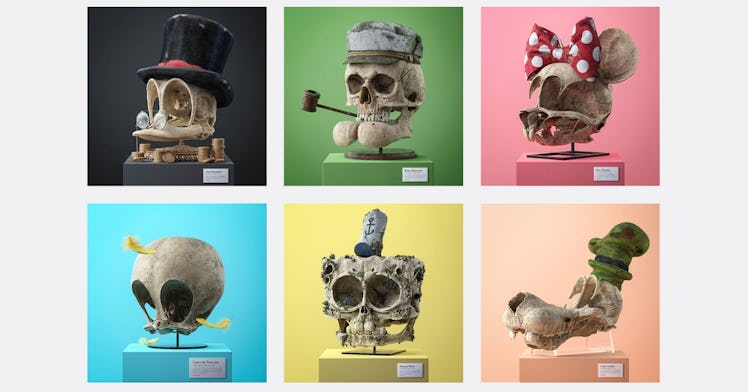The Skinless Skulls of Six Cartoon Characters Cannot Be Unseen
What if Minnie Mouse's bones were dug-up by a paleontologist?

Filip Hodas is a Prague-based digital artist with a knack for works that place modern cultural artifacts in contexts typically reserved for historical artifacts. Think a Stormtrooper helmet hidden in a remote rainforest or a steampunk Coca-Cola can half-buried in wetlands.
For his latest series “Cartoon Fossils,” Hodas takes the logical next step, placing 3D images of fossilized skulls of classic cartoon characters in museumlike contexts, out of the field and onto stands labeled with their Latin names.
“Initially, I wanted to make them stylized as dinosaur fossils set up in a museum environment, but later decided against it, as the skulls didn’t look very recognizable on their own—especially with parts broken or missing,” Hodas wrote introducing his online gallery. “That’s why I opted for [a] less damaged look and also added some assets to each of the characters.”
The resulting effect is undoubtedly surreal, with the characters both immediately recognizable and completely novel in their new condition and context. They’re definitely kind of creepy, but the bright backgrounds and whimsical touches make them more fascinating than frightening.
Against a yellow background that echoes his (former) exterior, the skull of Spongia Bobæ has what appears to be barnacles stuck to it, as you might expect from an aquatic specimen.
Mus Minnius’s fossil reveals what her teeth look like, something we’d never wondered about before that we now can’t stop thinking about.
Hodas also tackled one of the richest ducks in the world, Anas Scroogius, giving him the top hat and pince-nez that, apparently, “were surprisingly common among upper-class ducks of this era.”
The only human in the collection is Homo Popoculis, whose skull is an impressive shape, likely due to the consumption of large quantities of spinach, a calcium-rich food.
Canis Goofus may not have survived, but his signature felt hat and overbite both did.
Finally, the Canaria Tweetea has “the biggest recorded head to body ratio of all animals known to mankind,” but it’s probably the yellow feathers as much as the massive noggin that made her recognizable.
You can see more of Hodas’s work on his Instagram page.